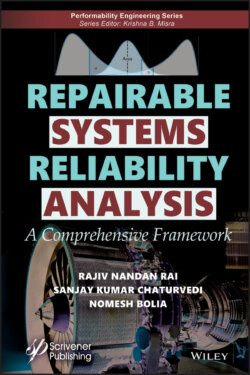Читать книгу Repairable Systems Reliability Analysis - Rajiv Nandan Rai - Страница 11
Оглавление
Preface
Conventionally, a repair action usually is assumed to renew a system to its “as good as new” condition. This assumption is very unrealistic for probabilistic modeling and leads to major distortions in statistical analysis. Most of the reliability literature is directed toward non-repairable systems, that is, systems that fail are discarded. This book is mainly dedicated toward providing coverage to the reliability modeling and analysis of repairable systems that are repaired and not replaced when they fail.
During his journey in the military organization, the first author realized that most of the industries desire to equip its scientists, engineers, and managers with the knowledge of reliability concepts and applications but have not been able to succeed completely. Repairable systems reliability analysis is an area where the research work is quite limited and very few text books are available. The available text books are also limited in providing a coverage only up to the concepts of non-homogeneous Poisson process (NHPP) where the repair effectiveness index (REI) is considered one. Few more textbooks provide knowledge only on non-parametric reliability analysis on repairable systems.
This book provides a comprehensive framework for the modeling and analysis of repairable systems considering both the non-parametric and parametric estimation of the failure data. The book provides due exposure to the generalized renewal process (GRP)–based arithmetic reduction of age (ARA) models along with its applications to repairable systems data from aviation industry. The book also covers various multi-criteria decision making (MCDM) techniques, integrated with repairable systems reliability analysis models to provide a much better insight into imperfect repair and maintenance data analysis. A complete chapter on an integrated framework for procurement process is added which will of a great assistance to the readers in enhancing the potential of their respective organization. It is intended to be useful for senior undergraduate, graduate, and post-graduate students in engineering schools as also for professional engineers, reliability administrators, and managers.
This book has primarily emerged from the industrial experience and research work of the authors. A number of illustrations have been included to make the subject pellucid and vivid even to the readers who are new to this area. Besides, various examples have been provided to showcase the applicability of presented models and methodologies, besides, to assist the readers in applying the concepts presented in the book.
The concepts of random variable and commonly used discrete and continuous probability distributions can readily be seen in various available texts that deal with reliability analysis of non-reparable systems. The reliability literature is in plenty to cover such aspects in reliability data analysis where the failure times are modeled by appropriate life distributions. Hence, the readers are advised to refer to any such text book on non-repairable systems reliability analysis for a better comprehension of this book.
Chapter 1 presents various terminologies pertaining to repairable systems followed by the description of repair concepts and repair categories.
The mean cumulative function (MCF)–based graphical and non-parametric methods for reparable systems are simple yet powerful option available to analyze the fleet/system events recurrence behavior and their recurrence rate. Chapter 2 is dedicated to MCF-based non-parametric analysis through examples with a case study of remotely operated vehicle (ROV).
The renewal and homogeneous Poisson processes (HPPs) followed by an exhaustive description of NHPP are covered in Chapter 3 along with solved examples. Thereafter, the chapter brings out a detailed description of ARA and ARI models along with their applicability in maintenance. The chapter also derives the maximum likelihood estimators (MLEs) for Kijima virtual age models with the help of GRP. The models are demonstrated with the help of suitable examples.
Chapter 4 provides various goodness-of-fit (GOF) tests for repairable systems and their applications with examples.
Chapter 5 presents various reliability and availability-based maintenance models for repairable systems. This chapter introduces the concept of high failure rate component (HFRC)–based thresholds and provides maintenance models by considering the “Black Box” (BB) approach followed by the failure mode (FM) approach. All the models are well-supported with examples.
This book presents modified failure modes and analysis (FMEA) model in Chapter 6. This model is based on the concept of REI propounded by Kijima and is best applicable to the repairable systems reliability analysis.
Chapter 7 provides an integrated approach for weapon procurement systems for military aviation. The combined applications of MCDM tools like AHP, ANP, and optimization techniques can be seen in this chapter. This model can be used for other industries procurement policy as well.
Chapter 8 is aimed at reducing the overhaul time of a repairable equipment to enhance the availability. Various concepts of throughput analysis have been utilized in this chapter.
The book makes an honest attempt to provide a comprehensive coverage to various models and methodologies that can be used for modeling and analysis of repairable systems reliability analysis. However, there is always a scope for improvement and we are looking forward to receiving critical reviews and/or comments of the book from students, teachers, and practitioners. We hope that the readers will all gain as much knowledge, understanding, and pleasure from reading this book as we have from writing it.
Rajiv Nandan Rai Sanjay Kumar Chaturvedi Nomesh Bolia August 2020
